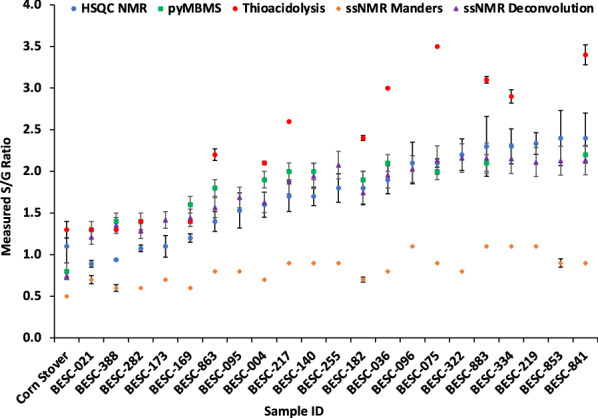Lignin Monomers Profiling Service
Promote Your Project Development with Lignin Monomers Analysis
Biomass such as lignocellulose contains lignin, which consists of p-hydroxyphenyl (H), syringyl (S), and O guaiacyl (G) units. The S/G ratio is often used to evaluate the application value of Biomasses such as Lignocellulose. Creative Biolabs provides a professional and reliable lignin monomers (lignin S/G ratio) analysis service according to a highly stable, reproducible, and sensitive analysis system. Our experienced researchers develop custom protocols according to sample type and client needs.
We analyze lignin monomer composition mainly by the detection of lignin S/G ratio. An accurate and reliable biomass lignin S/G ratio assay helps to optimize biomass conversion strategies and future energy crop engineering. It is also crucial for the selection of plant species and varieties for these purposes. Pyrolysis-gas chromatography-mass spectrometry (Py-GC-MS) is one of the commonly used assays. We have optimized the GC-MS analysis process to provide our clients with accurate and precise biomass lignin S/G ratio detection service. The method has been validated with good specificity, sensitivity, and reproducibility. The process of biomass lignin S/G ratio determination is as follows:
The samples are first milled, extracted, and removed from impurities to obtain lignin. The lignin is then pyrolyzed and analyzed by Py-GC-MS (the sample is split in half for detection). Finally, mass spectrometry data are collected and compared with standards to obtain the lignin S/G ratio in the samples.
 Fig.1 Reliable and efficient lignin S/G ratio analysis.
Fig.1 Reliable and efficient lignin S/G ratio analysis.
Advantages of Biomass Lignin S/G Ratio Analysis Service
-
Fast project delivery: We promise to improve the efficiency of our work under the premise of quality assurance so that our clients get more corroborative data in a faster way.
-
Professional biomass analysis team: We have a professional and experienced team in the development and analysis of testing technology.
-
Long-term experimental exploration: While meeting clients' basic testing needs, we develop and validate assays for complex samples to improve our ability to solve any analytical problems.
Creative Biolabs provides leading biomass lignin S/G ratio analysis services. Each analysis is strictly controlled by the quality control team until the report is delivered to the client. Please feel free to contact us for more details about biomass lignin S/G ratio analysis if you are interested in this area.
Published data
Plant biomass contains lignin, which consists of coniferyl or guaiacyl phenylpropanoid units, sinapyl or syringyl phenylpropanoid units, and others. It is found that the ratio of lignin units, especially the S/G ratio, may be a key biomass property in the biorefinery process, so efficient and accurate detection methods are important. In this study, several S/G ratio assay methods for detecting lignin in biomass were compared. The advantages and disadvantages of each method were also analyzed. It was found that thioacidolysis, pyrolysis-molecular beam mass spectrometry (py-MBMS), and other methods could provide representative, comprehensive, and accurate results for lignin analysis studies if compared within species. The selection of an appropriate S/G ratio assay method requires consideration of the method's limitations, the type of biomass being studied, and whether it is comparable to other biomasses. In this study, we learn some S/G ratio methods and method selection considerations, which provide data to support the optimization of S/G ratio detection methods.
 Fig.2 Comparison of S/G ratios measured, calculated, or predicted by different methods.1, 2
Fig.2 Comparison of S/G ratios measured, calculated, or predicted by different methods.1, 2
FAQs
Q1: What is the importance of lignin S/G ratio analysis for the utilization of biomass such as lignocellulose?
A1: Lignin is a complex phenolic compound consisting of three main monomers (G, S, and H). These monomers are linked in an irregular pattern through ester, ether, and C-C bonds. The composition of lignin varies according to genetic background and various biotic and abiotic factors. Among them, the S/G ratio directly affects the degradability of lignin and the cost of lignin conversion. Therefore, rapid and reliable methods for analyzing lignin S/G ratios are essential for assessing the value of plant utilization for biofuel production and for selecting plant species and varieties for these purposes.
Q2: What are the methods for measuring the S/G ratio of lignin in biomass?
A2: The S/G ratio of lignin varies significantly between plant types and cells. Various analytical methods have been developed to determine the lignin S/G ratio in plant cells, including high-performance liquid chromatography, ultra-high-performance liquid chromatography, GC-MS, etc. In addition to this, some spectroscopic methods such as ultraviolet, Fourier-transform infrared spectroscopy, and nuclear magnetic resonance have also been used for the determination of the lignin S/G ratio.
Customer Review
Extremely High Assay Efficiency
"As researchers focused on bioenergy, accurate quantification of lignin S/G ratio was an important part of our work. That's why we chose to work with Creative Biolabs. Their biomass lignin S/G ratio analysis service was fantastic. We appreciated their assay efficiency and commitment to delivering results within the specified time frame, which ensured that it would not affect our later experimental schedule."
Professional Analysis Team
"The biomass lignin S/G ratio analysis service provided by Creative Biolabs was very reliable. They advised us on how best to prepare our samples and always ensured that our samples were detected under optimized conditions. They were also available to answer any questions we had throughout the collaboration. They were both professional and friendly, which helped us to make progress."
References
-
Happs, Renee M., et al. "Comparison of methodologies used to determine aromatic lignin unit ratios in lignocellulosic biomass." Biotechnology for Biofuels 14 (2021): 1-16.
-
Under Open Access license CC BY 4.0, without modification.
For Research Use Only.
Related Services

 Fig.1 Reliable and efficient lignin S/G ratio analysis.
Fig.1 Reliable and efficient lignin S/G ratio analysis.
 Fig.2 Comparison of S/G ratios measured, calculated, or predicted by different methods.1, 2
Fig.2 Comparison of S/G ratios measured, calculated, or predicted by different methods.1, 2

